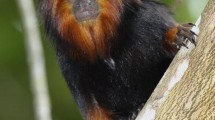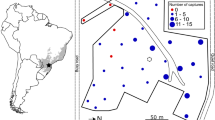Summary
This paper presents detailed data on the social relationships among the adults, and between the adults and young, of a cooperatively polyandrous saddle-back tamarin (Saguinus fusciollis; Callitrichidae) group studied for one year. Some data are also presented from groups studied in other years. Adult males in the study groups gave more grooming than they received, while the opposite was true for females (e.g. Fig. 1). The two polyandrous males in the main study group were very rarely aggressive to each other, rarely tried to disrupt each others' copulations, groomed each other, and occasionally shared food, suggesting that their relationship was more affiliative than agonistic. Data on grooming (Fig. 2), spatial relationships, and the initiation of copulations suggest that the males of this group, may have been somewhat more responsible than the female for the maintenance of male-female relationships. Both males and females performed all forms of parental care except lactation. In the main study group each of the males groomed the offspring and remained in close proximity to them more than did the female (Figs.3 and 4). These data are compared with existing data on social relationships in bird species that exhibit cooperative polyandry.
Similar content being viewed by others
References
Altmann J (1974) Observational study of behavior: sampling methods. Behaviour 49:227–267
Brown JL (1987) Helping and communal breeding in birds: Ecology and evolution. Princeton University Press, Princeton
Brown D, Mack DS (1978) Food sharing among captive Leontopithecus rosalia. Folia Primatol 29:268–290
Cebul MS, Epple G (1984) Father-offspring relationships in laboratory families of saddle-back tamarins (Saguinus fuscicollis). In: Taub DM (ed) Primate paternalism. van Nostrand Reinhold. New York, pp 1–19
Craig JL (1980) Pair and group breeding behaviour of a communal gallinule, the pukeko, Porphyrio p. melanotus. Anim Behav 28:593–603
Crook JH, Crook SJ (1988) Tibetan polyandry: Problems of adaptation and fitness. In: Betzig L, Borgerhoff Mulder M, Turke P (eds) Human reproductive behavior: A Darwinian analysis. Cambridge University Press, Cambridge
Davies NB (1983) Polyandry, cloaca pecking, and sperm competition in dunnocks. Nature 302:334–336
Davies NB (1985) Cooperation and conflict among dunnocks, Prunella modularis, in a variable mating system. Anim Behav 33:628–648
Davies NB (1986) Reproductive success of dunnocks, Prunella modularis, in a variable mating system. I. Factors influencing provisioning rate, nestling weight and fledging success. J Anim Ecol 55:123–138
Davies NB, Houston AI (1986) Reproductive success of dunnocks, Prunella modularis, in a variable mating system. II. Conflicts of interest among breeding adults. J Anim Ecol 55:139–154
Davies NB Lundberg A (1984) Food distribution and a variable mating system in the dunnock, Prunella modularis J Anim Ecol 53:895–912
De Vries T (1975) The breeding biology of the Galapagos hawk, Buteo galapagoensis. Le Gerfaut 65:29–57
Durham WH (1988) Coevolution: genes, culture and human diversity. Stanford University Press, Stanford (in press)
Epple G (1972) Social behavior of laboratory groups of Saguinus fuscicollis. In: Bridgewater PD (ed) Saving the lion marmoset. Proc WAPT Golden Lion Marmoset Conference, WAPT, Oglebay Park, Wheeling, pp 50–58
Epple G (1975) Parental behavior in Saguinus fuscicollis ssp. (Callitrichidae). Folia Primatol 24:221–238
Epple G, Katz Y (1980) Social influences on first reproductive success and related behaviors in the saddle-back tamarin (Saguinus fuscicollis, Callitrichidae). Int J Primatol 1:171–183
Faaborg J, Patterson CB (1981) The characteristics and occurrence of cooperative polyandry. Ibis 123:477–484
Ferrari SF (1987) Food transfer in a wild marmoset group. Folia Primatol 48:203–206
Garber PA (1986) Social organization and patterns of infant transport in Saguinus mystax in Amazonian Peru. Primate Report 14:78
Garnett ST (1978) The behaviour patterns of the dusky moorhen, Gallinula tenebrosa Gould (Aves: Rallidae). Aust Wildl Res 5:363–384
Garnett ST (1980) The social organization of the dusky moorhen, Gallinula tenebrosa Gould (Aves: Rallidae). Aust Wildl Res 7:103–112
Gengozian N, Batson JS, Smith TA (1978) Breeding of marmosets in a colony environment. Primates Med 10:71–78
Goldizen AW (1987a) Facultative polyandry and the role of infant-carrying in wild saddle-back tamarins (Saguinus fuscicollis). Behav Ecol Sociobiol 20:99–109
Goldizen AW (1987 b) Tamarins and marmosets: communal care of offspring. In: Smuts BB, Cheney DL, Seyfarth RM, Wrangham RW, Struhsaker TT (eds) Primate societies. University of Chicago Press, Chicago, pp 33–43
Goldizen AW (1988) Tamarin and marmoset mating systems: unusual flexibility. Trends Ecol Evol 3:36–40
Hinde RA (1983) Development and dynamics. In: Hinde RA (ed) Primate social relationships: an integrated approach. Sinauer, Sunderland, pp 65–70
Houston AI, Davies NB (1985) The evolution of cooperation and life history in the dunnock, Prunella modularis. In: Sibley RM, Smith RH (eds) Behavioral ecology: ecological consequences of adaptive behavior. Blackwell, Oxford, pp 471–487
Jamieson IG, Craig JL (1987) Dominance, and mating in a communal polygynandrous bird: cooperation or indifference towards mating competitors? Ethology 75:317–327
Joste NE, Koenig WD, Mumme RL Pitelka FA (1982) Intragroup dynamics of a cooperative breeder: an analysis of reproductive roles in the acorn woodpecker. Behav Ecol Sociobiol 11:195–201
Kleiman DG, Mack DS (1977) A peak in sexual activity during mid-pregnancy in the golden lion tamarin, Leontopithecus rosalia (Primates: Callitrichidae). J Mammal 58:657–660
Koenig WD, Mumme RL (1987) Population ecology of the cooperatively breeding acorn woodpecker. Princeton University Press, Princeton
Koenig WD, Mumme RL, Pitelka FA (1983) Female roles in cooperatively breeding acorn woodpeckers. In: Wasser SK (ed) Social behavior of female vertebrates. Academic Press, New York pp 235–261
Mader WJ (1979) Breeding behavior of a polyandrous trio of Harris' hawks in southern Arizona. Auk 96:776–788
Maynard Smith J, Ridpath MG (1972) Wife sharing in the Tasmanian native hen (Tribonyx mortierii): a case of kinship selection? Am Nat 106:447–452
McGrew WC (1988) Parental division of infant caretaking varies with family composition in cotton-top tamarins. Anim Behav 36:285–286
Oring LW (1986) Avian polyandry In: Johnston RF (ed) Current ornithology. Plenum Press, New York, pp 309–351
Ridpath MG (1972a) The Tasmanian native hen, Tribonyx mortierii. I. Patterns of behaviour. CSIRO Wildlife Res 17:1–51
Ridpath MG (1972b) The Tasmanian native hen, Tribonyx mortierii. II. The individual, the group, and the population. CSIRO Wildlife Res 17:53–90
Snowdon CT, Soini P (1988) The tamarins: genus Saguinus. In: Mittermeier RA, Coimbra-Filho AF (eds) Ecology and behavior of neotropical primates, vol 2. Academia Brasileira de Ciencias, Rio de Janeiro (in press)
Sokal RR, Rohlf FJ (1981) Biometry. Freeman, San Francisco
Stacey PB (1979) Kinship, promiscuity and communal breeding in the acorn woodpecker. Behav Ecol Sociobiol 6:53–66
Sussman RW, Kinzey WG (1984) The ecological role of the Callitrichidae A review. Am J Phys Anthropol 64:419–449
Terborgh J (1983) Five new world primates: a study in comparative ecology. Princeton University Press, Princeton
Terborgh J, Goldizen AW (1985) On the mating system of cooperatively breeding saddle-back tamarins (Saguinus fuscicollis). Behav Ecol Sociobiol 16:293–299
Vogt JL, Carlson H, Menzel E (1978) Social behavior of a marmoset (Saguinus fuscicollis) group. I. Parental care and infant development. Primates 19:715–726
Author information
Authors and Affiliations
Rights and permissions
About this article
Cite this article
Goldizen, A.W. Social relationships in a cooperatively polyandrous group of tamarins (Saguinus fuscicollis). Behav Ecol Sociobiol 24, 79–89 (1989). https://doi.org/10.1007/BF00299639
Received:
Accepted:
Issue Date:
DOI: https://doi.org/10.1007/BF00299639




